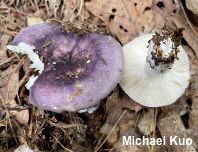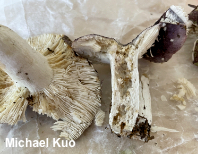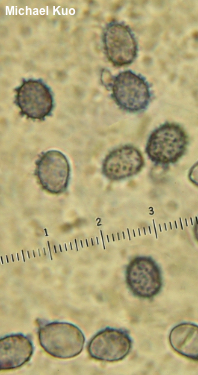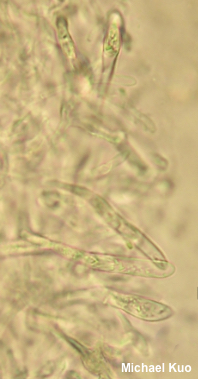| Major Groups > Gilled Mushrooms > Pale-Spored > Russula > Russula sericeonitens |

|
[ Basidiomycota > Russulales > Russulaceae > Russula . . . ] Russula sericeonitens by Michael Kuo, 1 October 2022 Until some graduate student armed with a DNA sequencer tells us this mushroom is actually a complex of 52 cryptic species, Russula sericeonitens is a fairly easily identified eastern North American mushroom (a rarity in the genus Russula). The cap is a gorgeous shade of purple, with a skin that is easily peeled away, the spore print, mature gills, and stem are white, and the taste of the flesh and gills is not at all bitter or acrid. Similar species include Russula mariae (which differs in its purplish stem, dusted cap, and creamy to pale yellow spore print), Russula queletii (with a purple stem), and Russula vinacea (cap usually more red than purple, stem staining gray with age, appearing earlier in the year). Russula sericeonitens is probably mycorrhizal, since it is a Russula—but its precise mycorrhizal association is unclear. Kauffman's original description of the species (1909) specifies "mixed woods of hemlock, maple and yellow birch in northern Michigan." However, some field guide authors treat the species as an oak associate. Binion et al. (2008), for example, report it in "mixed broadleaf forests containing oak." Given present-day knowledge of mycorrhizal associations, it is unlikely that a single species associates both with hemlock and with oaks. More likely is imprecise potential host documentation. The collection illustrated and described here was found under eastern hemlock, white oak, sugar maple, and eastern white pine. By "under" I mean that all these trees were within what I call "toppling range" of the mushrooms: if the tree were to fall over, some part of it, including the very top, could fall on the mushrooms. This range is farther than collectors usually consider, and can easily be 80 feet or more for mature trees—but I have seen clear evidence many times that "toppling" distance is not outside of mycorrhizal range. Did Kauffman fail to document oak trees in his "mixed woods" in northern Michigan? Or did Binion and collaborators fail to document hemlock in the "mixed broadleaf forests" where they found Russula sericeonitens? Both scenarios are quite possible, and more likely than a mycorrhizal mushroom associating with both oaks and hemlocks. Do you want to help solve the mystery? Next time you see Russula sericeonitens, document the trees within "toppling range" carefully, take photos of the mushrooms, preserve the collection, and send it to a public herbarium (mine, if you want, but please email first) so mycologists have access to your data! Description: Ecology: Mycorrhizal, with precise host association undetermined (probably either oak or hemlock; see the extended discussion above); growing alone, scattered, or gregariously; late summer and fall; originally described from northern Michigan; precise distribution uncertain but apparently limited to North America east of the Great Plains. The illustrated and described collection is from Ohio. Cap: 5–7 cm; convex, becoming broadly convex with a central depression; bald; dry; purple, with a darker area in the center; the skin easily peeling more than half the way to the center; the margin not lined. Gills: Broadly attached to the stem; close or crowded; short-gills infrequent; white; not staining. Stem: 4–5 cm long; 1–2 cm thick; more or less equal; dry; bald; white; not bruising; becoming hollow; basal mycelium white. Flesh: White; not changing when sliced. Odor and Taste: Not distinctive. Chemical Reactions: KOH on cap surface erasing purple to dull orange. Iron salts on stem surface negative. Spore Print: White. Microscopic Features: Spores 7–10 x 6–7 µm; ellipsoid; ornamentation as densely packed but isolated amyloid spines about 1 µm high, without connecting lines. Basidia42–46 x 8–11 µm; clavate; 4-sterigmate. Pleurocystidia 45–60 x 8–11 µm; fusiform; mucronate; smooth; thin-walled; hyaline in KOH. Pileipellis a partially gelatinized cutis; elements 2–5 µm wide, smooth, hyaline in KOH; pileocystidia 50–65 x 5–7.5 µm; clavate to cylindric with rounded apices; smooth; with weakly refractive contents in KOH. REFERENCES: C. H. Kauffman, 1909. (Murrill, 1915; Kauffman, 1918; Burlingham, 1942; Graham, 1944; Hesler, 1960; Kibby & Fatto, 1990; Phillips, 1991/2005; Binion et al., 2008.) Herb. Kuo 09132209. This site contains no information about the edibility or toxicity of mushrooms. |
© MushroomExpert.Com |
|
Cite this page as: Kuo, M. (2022, October). Russula sericeonitens. Retrieved from the MushroomExpert.Com Web site: http://www.mushroomexpert.com/russula_sericeonitens.html |



